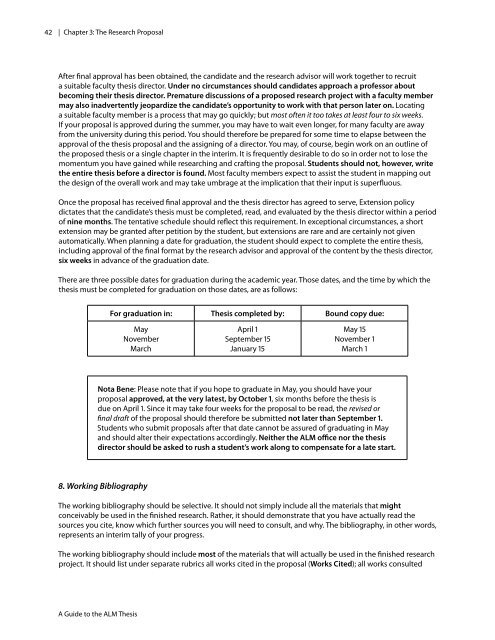A Guide to the ALM Thesis - iSites - Harvard University
A Guide to the ALM Thesis - iSites - Harvard University
A Guide to the ALM Thesis - iSites - Harvard University
Create successful ePaper yourself
Turn your PDF publications into a flip-book with our unique Google optimized e-Paper software.
42<br />
| Chapter 3: The Research Proposal<br />
After final approval has been obtained, <strong>the</strong> candidate and <strong>the</strong> research advisor will work <strong>to</strong>ge<strong>the</strong>r <strong>to</strong> recruit<br />
a suitable faculty <strong>the</strong>sis direc<strong>to</strong>r. Under no circumstances should candidates approach a professor about<br />
becoming <strong>the</strong>ir <strong>the</strong>sis direc<strong>to</strong>r. Premature discussions of a proposed research project with a faculty member<br />
may also inadvertently jeopardize <strong>the</strong> candidate’s opportunity <strong>to</strong> work with that person later on. Locating<br />
a suitable faculty member is a process that may go quickly; but most often it <strong>to</strong>o takes at least four <strong>to</strong> six weeks.<br />
If your proposal is approved during <strong>the</strong> summer, you may have <strong>to</strong> wait even longer, for many faculty are away<br />
from <strong>the</strong> university during this period. You should <strong>the</strong>refore be prepared for some time <strong>to</strong> elapse between <strong>the</strong><br />
approval of <strong>the</strong> <strong>the</strong>sis proposal and <strong>the</strong> assigning of a direc<strong>to</strong>r. You may, of course, begin work on an outline of<br />
<strong>the</strong> proposed <strong>the</strong>sis or a single chapter in <strong>the</strong> interim. It is frequently desirable <strong>to</strong> do so in order not <strong>to</strong> lose <strong>the</strong><br />
momentum you have gained while researching and crafting <strong>the</strong> proposal. Students should not, however, write<br />
<strong>the</strong> entire <strong>the</strong>sis before a direc<strong>to</strong>r is found. Most faculty members expect <strong>to</strong> assist <strong>the</strong> student in mapping out<br />
<strong>the</strong> design of <strong>the</strong> overall work and may take umbrage at <strong>the</strong> implication that <strong>the</strong>ir input is superfluous.<br />
Once <strong>the</strong> proposal has received final approval and <strong>the</strong> <strong>the</strong>sis direc<strong>to</strong>r has agreed <strong>to</strong> serve, Extension policy<br />
dictates that <strong>the</strong> candidate’s <strong>the</strong>sis must be completed, read, and evaluated by <strong>the</strong> <strong>the</strong>sis direc<strong>to</strong>r within a period<br />
of nine months. The tentative schedule should reflect this requirement. In exceptional circumstances, a short<br />
extension may be granted after petition by <strong>the</strong> student, but extensions are rare and are certainly not given<br />
au<strong>to</strong>matically. When planning a date for graduation, <strong>the</strong> student should expect <strong>to</strong> complete <strong>the</strong> entire <strong>the</strong>sis,<br />
including approval of <strong>the</strong> final format by <strong>the</strong> research advisor and approval of <strong>the</strong> content by <strong>the</strong> <strong>the</strong>sis direc<strong>to</strong>r,<br />
six weeks in advance of <strong>the</strong> graduation date.<br />
There are three possible dates for graduation during <strong>the</strong> academic year. Those dates, and <strong>the</strong> time by which <strong>the</strong><br />
<strong>the</strong>sis must be completed for graduation on those dates, are as follows:<br />
For graduation in: <strong>Thesis</strong> completed by: Bound copy due:<br />
May<br />
November<br />
March<br />
April 1<br />
September 15<br />
January 15<br />
May 15<br />
November 1<br />
March 1<br />
Nota Bene: Please note that if you hope <strong>to</strong> graduate in May, you should have your<br />
proposal approved, at <strong>the</strong> very latest, by Oc<strong>to</strong>ber 1, six months before <strong>the</strong> <strong>the</strong>sis is<br />
due on April 1. Since it may take four weeks for <strong>the</strong> proposal <strong>to</strong> be read, <strong>the</strong> revised or<br />
final draft of <strong>the</strong> proposal should <strong>the</strong>refore be submitted not later than September 1.<br />
Students who submit proposals after that date cannot be assured of graduating in May<br />
and should alter <strong>the</strong>ir expectations accordingly. Nei<strong>the</strong>r <strong>the</strong> <strong>ALM</strong> office nor <strong>the</strong> <strong>the</strong>sis<br />
direc<strong>to</strong>r should be asked <strong>to</strong> rush a student’s work along <strong>to</strong> compensate for a late start.<br />
8. Working Bibliography<br />
The working bibliography should be selective. It should not simply include all <strong>the</strong> materials that might<br />
conceivably be used in <strong>the</strong> finished research. Ra<strong>the</strong>r, it should demonstrate that you have actually read <strong>the</strong><br />
sources you cite, know which fur<strong>the</strong>r sources you will need <strong>to</strong> consult, and why. The bibliography, in o<strong>the</strong>r words,<br />
represents an interim tally of your progress.<br />
The working bibliography should include most of <strong>the</strong> materials that will actually be used in <strong>the</strong> finished research<br />
project. It should list under separate rubrics all works cited in <strong>the</strong> proposal (Works Cited); all works consulted<br />
A <strong>Guide</strong> <strong>to</strong> <strong>the</strong> <strong>ALM</strong> <strong>Thesis</strong>

















